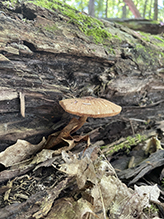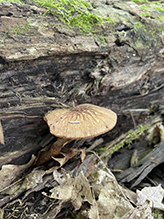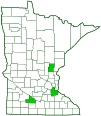Wrinkled Psathyrella
(Typhrasa gossypina)
Conservation • Description • Habitat • Ecology • Distribution • Taxonomy
Conservation Status |
|
|||||||
| IUCN Red List | not listed |
|||||||
| NatureServe | not listed |
|||||||
| Minnesota | not listed |
|||||||
Description |
||
Wrinkled Psathyrella is a medium-sized gilled mushroom. It occurs in western Europe and eastern United States. It is uncommon in Minnesota, where it reaches the western extent of its range. From July through September, it appears alone, scattered, close together but not in clusters (gregarious), or in clusters, in forests and woodlands. It grows on dead and already decayed hardwood, on mulch, and on woody debris. It obtains its nutrients from dead wood (saprobic). When it first appears, the cap is cone-shaped to bell-shaped, dark brown to dark reddish-brown, and lined (striate) on the margin. When wet it is opaque, but as it dries out the drier tissue becomes light yellowish-brown and unevenly transparent. When the edge of the cap dries the gills on the underside show through. The upper surface is sometimes covered with white hair-like fibers (fibrillose). There are often white tissue fragments, remnants of the partial veil, hanging from the margins. As it ages it first becomes convex then flattens out, sometimes retaining a broad raised knob in the middle (umbonate), and fades to brownish or tan. The mature cap is 1¼″ to 4″ (3 to 10 cm) in diameter. The upper surface is coarsely, radially wrinkled. The gills are pale brown at first, becoming dark brown with age. They are broadly attached to the stalk (adnate) and medium-spaced apart. The edges become minutely fringed and sometimes whitish with age. The stalk is 2⅜″ to 4″ (6 to 10 cm) long 3⁄16″ to ⅝″ (5 to 15 mm) thick. It is hollow and whitish when young, becoming brownish below. The upper part is covered with white powdery particles (pruinose), and the base is usually covered with long, white, thread-like fibers (mycelium). There is no true ring of tissue but there are sometimes remnants of the partial veil loosely clinging to the stalk. The flesh is pale brown, thin, fragile, and watery. It is edible but the taste is not distinctive. Eating is not recommended due to the difficulty in accurately identifying this species. The spore print is purplish-brown to purplish-black. |
||
Similar Species |
||
Habitat and Hosts |
||
Forests and woodlands Decaying hardwood, mulch, and woody debris |
||
Ecology |
||
Season |
||
July through September |
||
Distribution |
||||
|
Sources |
|||
| 8/3/2022 | ||||
Occurrence |
||||
|
||||
Taxonomy |
|||
| Kingdom | Fungi (Fungi) | ||
| Subkingdom | Dikarya | ||
| Phylum | Basidiomycota (Basidiomycete Fungi) | ||
| Subphylum | Agaricomycotina (Higher Basidiomycetes) | ||
| Class | Agaricomycetes (Mushrooms, Bracket Fungi, Puffballs, and Allies) | ||
| Subclass | Agaricomycetidae | ||
| Order | Agaricales (Common Gilled Mushrooms and Allies) | ||
| Suborder | Agaricineae | ||
| Family | Psathyrellaceae (brittlestems and allies) | ||
Genus |
Typhrasa | ||
This species was formerly classified as Psathyrella delineata. A recent phylogenetic analysis (Örstadius, et al., 2015) determined that Psathyrella delineata and Psathyrella canadensis were the same. Both were transferred to the new genus Typhrasa and became the single species Typhrasa gossypina. |
|||
Synonyms |
|||
Agaricus gossypinus Drosophila delineata Hypholoma delineatum Psathyrella delineata Psathyrella gossypina Typhrasa delineata |
|||
Common Names |
|||
Artist Crumblecap Wrinkled-cap Psathyrella Wrinkled Psathyrella |
|||
Glossary
Fibrillose
On mushrooms, covered with fine hair-like fibers.
Mycelium
The vegetative part of a fungus; consisting of a mass of branching, thread-like hyphae, through which a fungus absorbs nutrients from its environment; and excluding the fruiting, reproductive structure.
Partial veil
A protective covering over the gills or pores of a developing mushroom. At maturity it disappears, collapses into a ring around the stalk, or wears away into a cobwebby covering and ring zone.
Saprobic
A term often used for saprotrophic fungi. Referring to fungi that obtain their nutrients from decayed organic matter.
Striate
Striped or grooved in parallel lines (striae).
Umbonate
On mushrooms, having a distinct, raised, knob-like projection in the center of the cap.
New Name Needed
This species was moved to a new genus in 2015, and its common name “Wrinkled Psathyrella” moved with it. The common name now refers to its former genus. An alternate name is “Artist Crumblecap,” but that name is rarely used.
Visitor Photos |
|||||
Share your photo of this fungus. |
|||||
| This button not working for you? Simply email us at info@MinnesotaSeasons.com. Attach one or more photos and, if you like, a caption. |
|||||
Honey Fae (Farah) |
|||||
Wrinkled-cap Psathyrella found growing out of fallen oak tree. |
|||||
 |
 |
||||
MinnesotaSeasons.com Photos |
|||||
|
|||||

Visitor Videos |
|||
Share your video of this fungus. |
|||
| This button not working for you? Simply email us at info@MinnesotaSeasons.com. Attach a video, a YouTube link, or a cloud storage link. |
|||
Other Videos |
|||

Visitor Sightings |
|||||
Report a sighting of this fungus. |
|||||
| This button not working for you? Simply email us at info@MinnesotaSeasons.com. Be sure to include a location. |
|||||
| Honey Fae (Farah) 7/9/2022 |
Location: Hennepin County Wrinkled-cap Psathyrella found growing out of fallen oak tree. |
||||
MinnesotaSeasons.com Sightings |
|||||
|
|||||

Created: 8/3/2022
Last Updated:



